Temporal and Spatial Changes in Crop Water Use Efficiency in Central Asia from 1960 to 2016
Abstract
1. Introduction
2. Data and Methodology
2.1. Study Area
2.2. Data
2.3. Methodology
2.3.1. Spatialization of Crop Planting Structure and Yield in Central Asia from 1960 to 2016
2.3.2. Calculate Crop Evapotranspiration, Virtual Water and Water Use Efficiency
3. Results
3.1. Temporal and Spatial Changes in Crop Planting Structures in Central Asia from 1960 to 2016
3.2. Water Consumption and Yield Changes in Central Asia from 1960 to 2016
3.3. Temporal Changes in Virtual Water in Central Asia from 1960 to 2016
3.4. Temporal and Spatial Changes in Crop Water Use Efficiency in Central Asia from 1960 to 2016
4. Discussion
4.1. Comparison with Previous Studies
4.2. Analysis of Factors Affecting Crop water Use Efficiency in Central Asia
4.3. Policy Implications
5. Conclusions
- In the past 60 years, the sown area of the five Central Asian countries has experienced three periods: expansion (1960–1990), reduction (1990–2000), and restoration (2000–2016);
- The grain yield in Central Asia increased from 0.9 t/ha in 1960 to 1.9 t/ha in 2016. The cotton yield increased from 1.9 to 2.6 t/ha from 1960 to 1990, and has declined significantly since the 1990s. However, water consumption per hectare has not changed significantly; the consumption rate of grain and cotton is 4326–5417 m3/ha and 8155–9157 m3/ha, respectively. Compared with grain, cotton is a high water-consuming crop. Under constant sown areas, reducing the proportion of cotton area can reduce the total water consumption of crops;
- The grain water use efficiency increased from 0.22 to 0.39 kg/m3 during 1960–2016. Tajikistan and Uzbekistan have experienced significant growth since 1990. The cotton water use efficiency increased from 0.23 to 0.30 kg/m3 during 1960–1990, has decreased since 1990, and was only 0.22 kg/m3 in 2016.
Author Contributions
Funding
Conflicts of Interest
References
- Chen, Y.; Li, Z.; Fang, G.; Li, W. Large hydrological processes changes in the transboundary rivers of central Asia. J. Geophys. Res. Atmos. 2018, 123, 5059–5069. [Google Scholar] [CrossRef]
- Sorg, A.; Mosello, B.; Shalpykova, G.; Allan, A.; Hill Clarvis, M.; Stoffel, M. Coping with changing water resources: The case of the Syr Darya river basin in Central Asia. Environ. Sci. Policy 2014, 43, 68–77. [Google Scholar] [CrossRef]
- Yu, Y.; Pi, Y.Y.; Yu, X.; Ta, Z.J.; Sun, L.X.; Disse, M.; Zeng, F.J.; Li, Y.M.; Chen, X.; Yu, R.D. Climate change, water resources and sustainable development in the arid and semi-arid lands of Central Asia in the past 30 years. J. Arid Land 2019, 11, 1–14. [Google Scholar] [CrossRef]
- Immerzeel, W.W.; van Beek, L.P.; Bierkens, M.F. Climate change will affect the Asian water towers. Science 2010, 328, 1382–1385. [Google Scholar] [CrossRef]
- Kubo, H.; Tateno, K.; Watanabe, A.; Kato, Y. Human and environmental symbiosis in Central Asia: through the water management of the aral sea basin crisis. Transit. Stud. Rev. 2009, 16, 467–478. [Google Scholar] [CrossRef]
- Issanova, G.; Jilili, R.; Abuduwaili, J.; Kaldybayev, A.; Saparov, G.; Yongxiao, G. Water availability and state of water resources within water-economic basins in Kazakhstan. Paddy Water Environ. 2018, 16, 183–191. [Google Scholar] [CrossRef]
- Lerman, Z.; Sedik, D. Transition to smallholder agriculture in Central Asia. J. Agrar. Chang. 2018, 18, 904–912. [Google Scholar] [CrossRef]
- Zhou, Y.; Zhang, L.; Xiao, J.; Williams, C.A.; Vitkovskaya, I.; Bao, A. Spatiotemporal transition of institutional and socioeconomic impacts on vegetation productivity in Central Asia over last three decades. Sci. Total Environ. 2019, 658, 922–935. [Google Scholar] [CrossRef]
- Wei, W.; Zhu, Y.; Li, H.; Zhang, K.; Wang, B.; Yang, X.; Shi, Z. Spatio-temporal reorganization of cropland development in Central Asia during the post-soviet era: A sustainable implication in Kazakhstan. Sustainability 2018, 10, 4042. [Google Scholar] [CrossRef]
- Suleimenov, M. Trends in the agriculture of Central Asia and implications for rangelands and croplands. In Novel Measurement and Assessment Tools for Monitoring and Management of Land and Water Resources in Agricultural Landscapes of Central Asia; Springer International: Basel, Switzerland, 2014. [Google Scholar]
- Ibragimov, N.; Evett, S.R.; Esanbekov, Y.; Kamilov, B.S.; Mirzaev, L.; Lamers, J.P.A. Water use efficiency of irrigated cotton in Uzbekistan under drip and furrow irrigation. Agric. Water Manag. 2007, 90, 112–120. [Google Scholar] [CrossRef]
- Kulmatov, R.; Groll, M.; Rasulov, A.; Soliev, I.; Romic, M. Status quo and present challenges of the sustainable use and management of water and land resources in Central Asian irrigation zones-The example of the Navoi region (Uzbekistan). Quat. Int. 2018, 464, 396–410. [Google Scholar] [CrossRef]
- Djumaboev, K.; Hamidov, A.; Anarbekov, O.; Gafurov, Z.; Tussupova, K. Impact of institutional change on irrigation management: A case study from Southern Uzbekistan. Water 2017, 9, 419. [Google Scholar] [CrossRef]
- Porkka, M.; Kummu, M.; Siebert, S.; Flörke, M. The role of virtual water flows in physical water scarcity: The case of Central Asia. Int. J. Water Resour. Dev. 2012, 28, 453–474. [Google Scholar] [CrossRef]
- Rudenko, I.; Bekchanov, M.; Djanibekov, U.; Lamers, J.P.A. The added value of a water footprint approach: Micro-and macroeconomic analysis of cotton production, processing and export in water bound Uzbekistan. Glob. Planet. Chang. 2013, 110, 143–151. [Google Scholar] [CrossRef]
- Zhang, J.; Chen, Y.; Li, Z. Assessment of efficiency and potentiality of agricultural resources in Central Asia. J. Geogr. Sci. 2018, 28, 1329–1340. [Google Scholar] [CrossRef]
- Sun, J.; Li, Y.P.; Suo, C.; Liu, Y.R. Impacts of irrigation efficiency on agricultural water-land nexus system management under multiple uncertainties—A case study in Amu Darya River basin, Central Asia. Agric. Water Manag. 2019, 216, 76–88. [Google Scholar] [CrossRef]
- Gilbert, M.E.; Hernandez, M.I. How should crop water-use efficiency be analyzed? A warning about spurious correlations. Field Crop. Res. 2019, 235, 59–67. [Google Scholar] [CrossRef]
- Blum, A. Drought resistance, water-use efficiency, and yield potential—are they compatible, dissonant, or mutually exclusive? Aust. J. Agric. Res. 2005, 56, 1159–1168. [Google Scholar] [CrossRef]
- Mbava, N.; Mutema, M.; Zengeni, R.; Shimelis, H.; Chaplot, V. Factors affecting crop water use efficiency: A worldwide meta-analysis. Agric. Water Manag. 2020, 228, 105878. [Google Scholar] [CrossRef]
- Zhou, X.; Wang, R.; Gao, F.; Xiao, H.; Xu, H.; Wang, D. Apple and maize physiological characteristics and water-use efficiency in an alley cropping system under water and fertilizer coupling in Loess Plateau, China. Agric. Water Manag. 2019, 221, 1–12. [Google Scholar] [CrossRef]
- Reddy, J.M.; Muhammedjanov, S.; Jumaboev, K.; Eshmuratov, D. Analysis of cotton water productivity in Fergana Valley of Central Asia. Agric. Sci. 2012, 3, 822–834. [Google Scholar] [CrossRef][Green Version]
- Dağdelen, N.; Yılmaz, E.; Sezgin, F.; Gürbüz, T. Water-yield relation and water use efficiency of cotton (Gossypium hirsutum L.) and second crop corn (Zea mays L.) in western Turkey. Agric. Water Manag. 2006, 82, 63–85. [Google Scholar] [CrossRef]
- Gao, Y.; Duan, A.; Sun, J.; Li, F.; Liu, Z.; Liu, H.; Liu, Z. Crop coefficient and water-use efficiency of winter wheat/spring maize strip intercropping. Field Crop. Res. 2009, 111, 65–73. [Google Scholar] [CrossRef]
- Zhang, J.; Chen, Y.; Li, Z.; Song, J.; Fang, G.; Li, Y.; Zhang, Q. Study on the utilization efficiency of land and water resources in the Aral Sea Basin, Central Asia. Sustain. Cities Soc. 2019, 51, 101693. [Google Scholar] [CrossRef]
- Gao, H.; Yan, C.; Liu, Q.; Li, Z.; Yang, X.; Qi, R. Exploring optimal soil mulching to enhance yield and water use efficiency in maize cropping in China: A meta-analysis. Agric. Water Manag. 2019, 225, 105741. [Google Scholar] [CrossRef]
- Foster, T.; Brozović, N. Simulating crop-water production functions using crop growth models to support water policy assessments. Ecol. Econ. 2018, 152, 9–21. [Google Scholar] [CrossRef]
- Mbangiwa, N.C.; Savage, M.J.; Mabhaudhi, T. Modelling and measurement of water productivity and total evaporation in a dryland soybean crop. Agric. For. Meteorol. 2019, 266, 65–72. [Google Scholar] [CrossRef]
- Tan, M.; Zheng, L. Increase in economic efficiency of water use caused by crop structure adjustment in arid areas. J. Environ. Manag. 2019, 230, 386–391. [Google Scholar] [CrossRef]
- Pohanková, E.; Hlavinka, P.; Orság, M.; Takáč, J.; Kersebaum, K.C.; Gobin, A.; Trnka, M. Estimating the water use efficiency of spring barley using crop models. J. Agric. Sci. 2018, 156, 628–644. [Google Scholar] [CrossRef]
- Li, F.; Zhan, C.; Xu, Z.; Jiang, S.; Xiong, J. Remote sensing monitoring on regional crop water productivity in the Haihe River Basin. J. Geogr. Sci. 2013, 23, 1080–1090. [Google Scholar] [CrossRef]
- Xu, Z.; Chen, X.; Wu, S.R.; Gong, M.; Du, Y.; Wang, J.; Li, Y.; Liu, J. Spatial-temporal assessment of water footprint, water scarcity and crop water productivity in a major crop production region. J. Clean. Prod. 2019, 224, 375–383. [Google Scholar] [CrossRef]
- Weiss, M.; Jacob, F.; Duveiller, G. Remote sensing for agricultural applications: A meta-review. Remote Sens. Environ. 2020, 236, 111402. [Google Scholar] [CrossRef]
- Blatchford, M.L.; Mannaerts, C.M.; Zeng, Y.; Nouri, H.; Karimi, P. Status of accuracy in remotely sensed and in-situ agricultural water productivity estimates: A review. Remote Sens. Environ. 2019, 234, 111413. [Google Scholar] [CrossRef]
- Platonov, A.; Thenkabail, P.S.; Biradar, C.M.; Cai, X.; Gumma, M.; Dheeravath, V.; Cohen, Y.; Alchanatis, V.; Goldshlager, N.; Ben-Dor, E.; et al. Water productivity mapping (WPM) using landsat etm + data for the irrigated croplands of the Syrdarya River Basin in Central Asia. Sensors 2008, 8, 8156–8180. [Google Scholar] [CrossRef] [PubMed]
- Campos, I.; Neale, C.M.U.; Arkebauer, T.J.; Suyker, A.E.; Gonçalves, I.Z. Water productivity and crop yield: A simplified remote sensing driven operational approach. Agric. For. Meteorol. 2018, 249, 501–511. [Google Scholar] [CrossRef]
- Chen, Y.N.; Li, W.H.; Deng, H.J.; Fang, G.H.; Li, Z. Changes in Central Asia’s water tower: Past, present and future. Sci. Rep.-UK 2016, 6, 35458. [Google Scholar] [CrossRef] [PubMed]
- Hamidov, A.; Helming, K.; Balla, D. Impact of agricultural land use in Central Asia: A review. Agron. Sustain. Dev. 2016, 36, 6. [Google Scholar] [CrossRef]
- Kjaersgaard, J.H.; Plauborg, F.; Mollerup, M.; Petersen, C.T.; Hansen, S. Crop coefficients for winter wheat in a sub-humid climate regime. Agric. Water Manag. 2008, 95, 918–924. [Google Scholar] [CrossRef]
- Sommer, R.; Glazirina, M.; Yuldashev, T.; Otarov, A.; Ibraeva, M.; Martynova, L.; Bekenov, M.; Kholov, B.; Ibragimov, N.; Kobilov, R.; et al. Impact of climate change on wheat productivity in Central Asia. Agric. Ecosyst. Environ. 2013, 178, 78–99. [Google Scholar] [CrossRef]
- Conrad, C.; Schorcht, G.; Tischbein, B.; Davletov, S.; Sultonov, M.; Lamers, J.P. Agro-meteorological trends of recent climate development in Khorezm and implications for crop production. In Cotton, Water, Salts and Soums; Springer: Dordrecht, the Netherlands, 2012. [Google Scholar]
- Smith, M.; Allen, R.; Monteith, J.; Perrier, A.; Segeren, A. Report. expert consultation on revision of FAO methodologies for crop water requirements. In Proceedings of the Expert Consultation on Revision of FAO Methodologies for Crop Water Requirements, Rome, Italy, 28–31 May 1990. [Google Scholar]
- Hoekstra, A.Y.; Hung, P.Q. Globalisation of water resources: International virtual water flows in relation to crop trade. Glob. Environ. Chang. 2005, 15, 45–56. [Google Scholar] [CrossRef]
- Abdullaev, I.; Molden, D. Spatial and temporal variability of water productivity in the Syr Darya Basin, central Asia. Water Resour. Res. 2004, 40. [Google Scholar] [CrossRef]
- Mogilevskii, R.; Abdrazakova, N.; Bolotbekova, A.; Chalbasova, S.; Dzhumaeva, S.; Tilekeyev, K. The Outcomes of 25 Years of Agricultural Reforms in KYRGYZSTAN; Discussion Paper, Leibniz Institute of Agricultural Development: Halle, Germany, 2017. [Google Scholar]
- Duan, W.; Chen, Y.; Zou, S.; Nover, D. Managing the water-climate- food nexus for sustainable development in Turkmenistan. J. Clean. Prod. 2019, 220, 212–224. [Google Scholar] [CrossRef]
- Bekchanov, M.; Ringler, C.; Bhaduri, A.; Jeuland, M. Optimizing irrigation efficiency improvements in the Aral Sea Basin. Water Resour. Econ. 2016, 13, 30–45. [Google Scholar] [CrossRef]
- Alipbeki, O.; Kabzhanova, G.; Alipbekova, C. Use of operational remote sensing in forecasting of wheat production in nothern kazakhstan. Int. Multidiscip. Sci. GeoConference SGEM Surv. Geol. Min. Ecol. Manag. 2016, 2, 1051–1057. [Google Scholar]
- Safarova, A.; Khasankhanova, G. Water and Land Management and Agricultural Policy in Support of Food Security: The Amu Darya Delta in Uzbekistan; Case Study, Cornell University: Ithaca, NY, USA, 2016. [Google Scholar]
- Suleimenov, M.; Kiyas, A.; Kaskarbayev, Z. Replacement of summer fallow with oats and food legumes on black soils of northern Kazakhstan. Asian Aust. J. Plant Sci. Biotechnol. 2010, 4, 81–86. [Google Scholar]

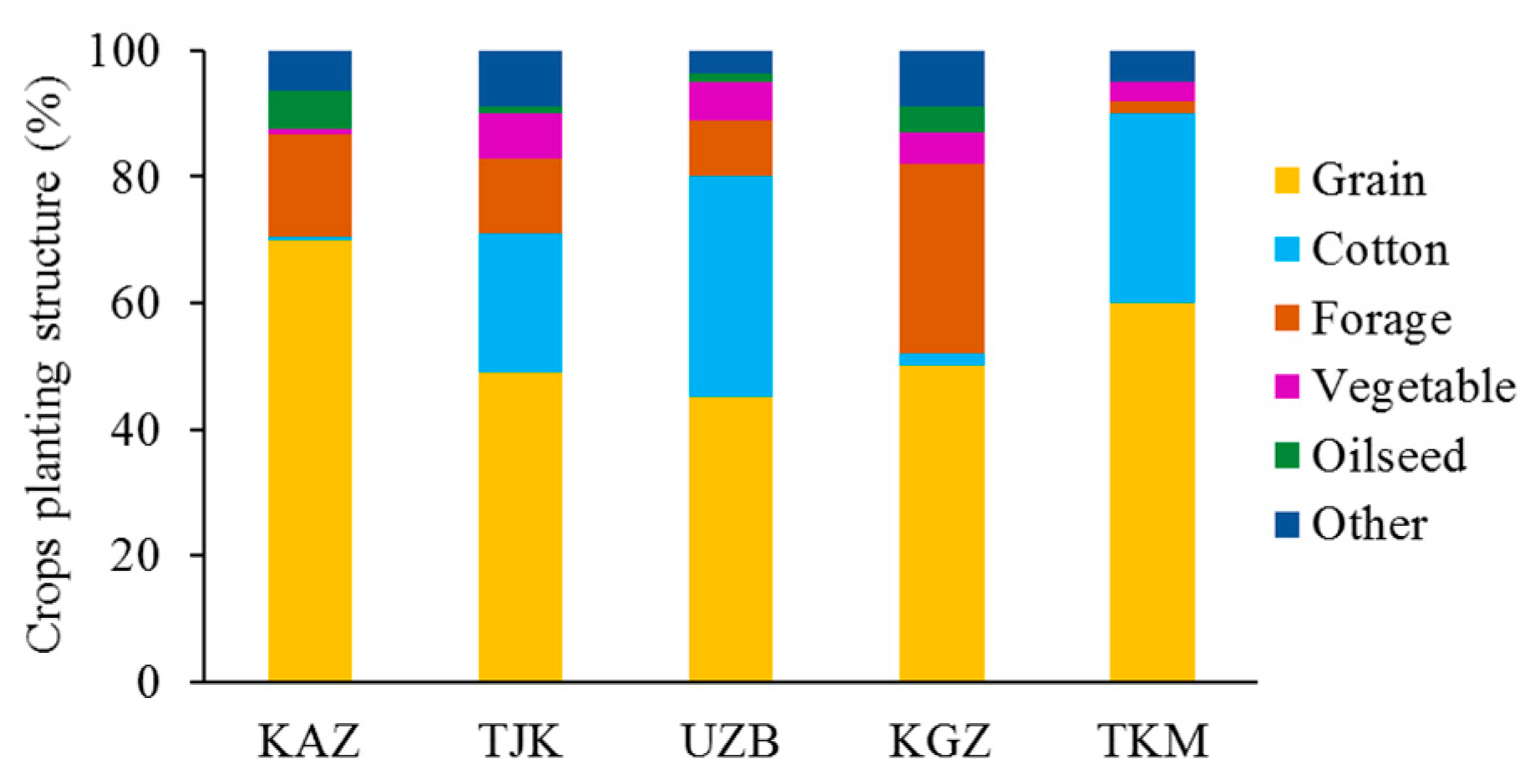
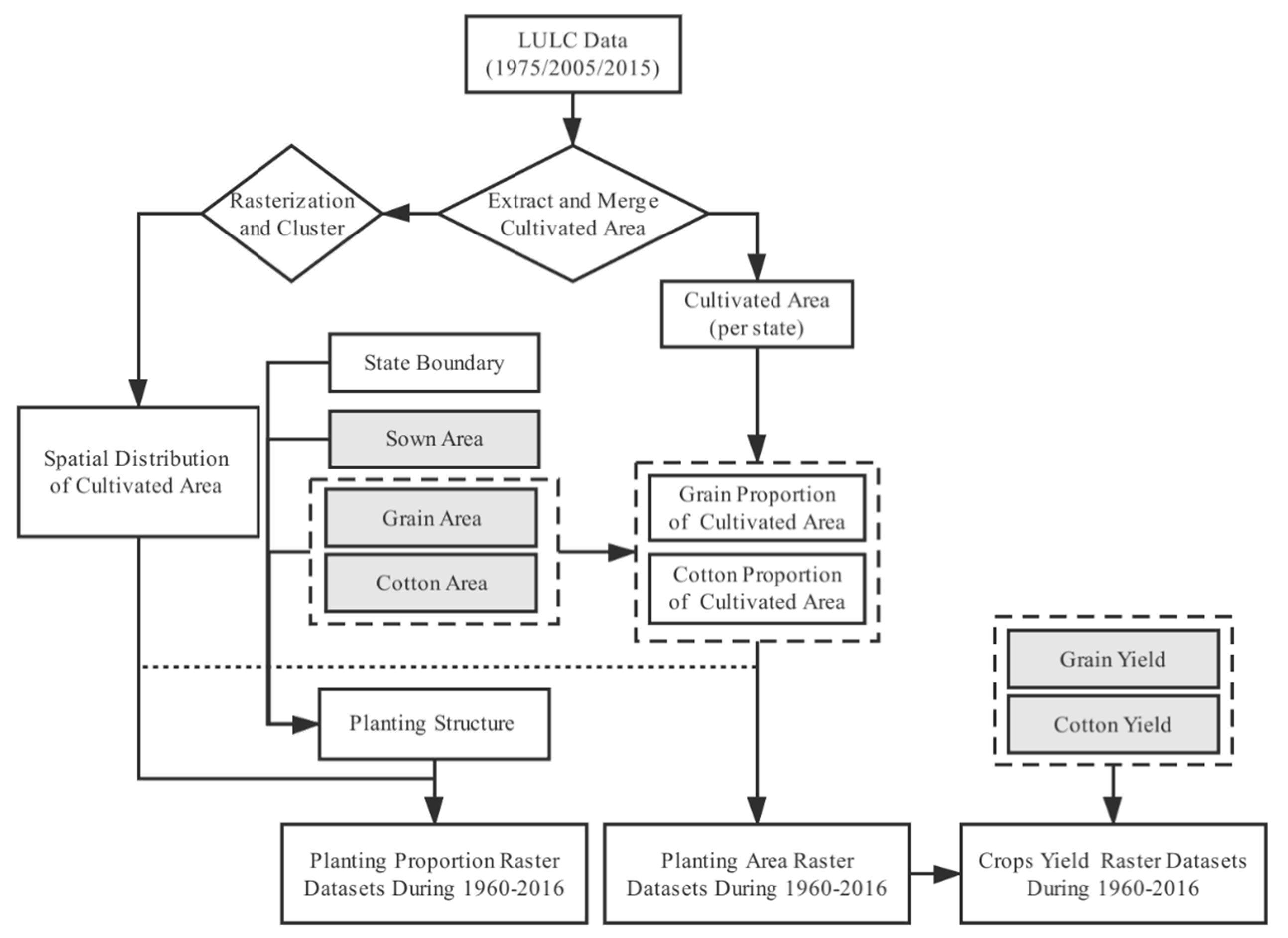
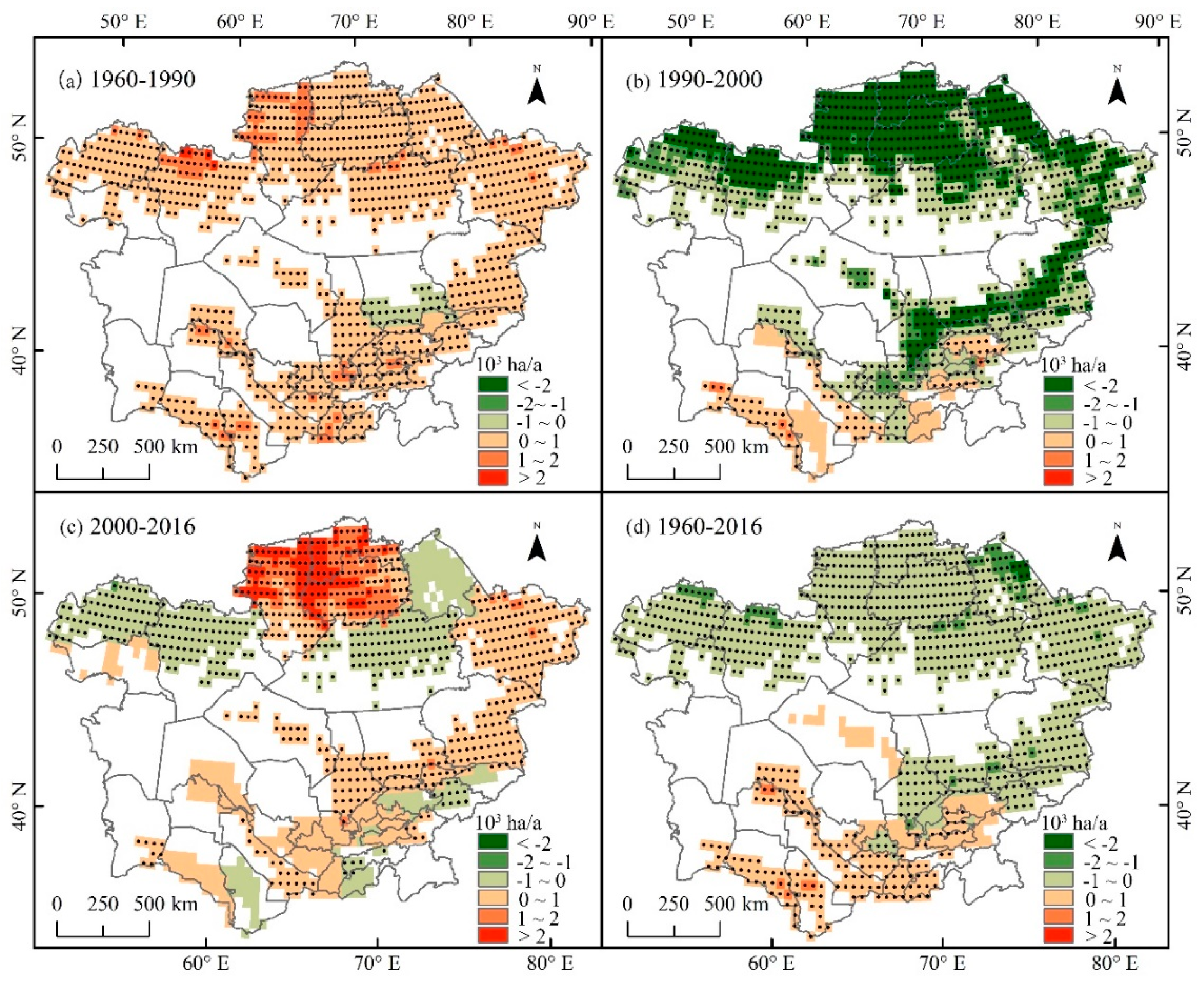
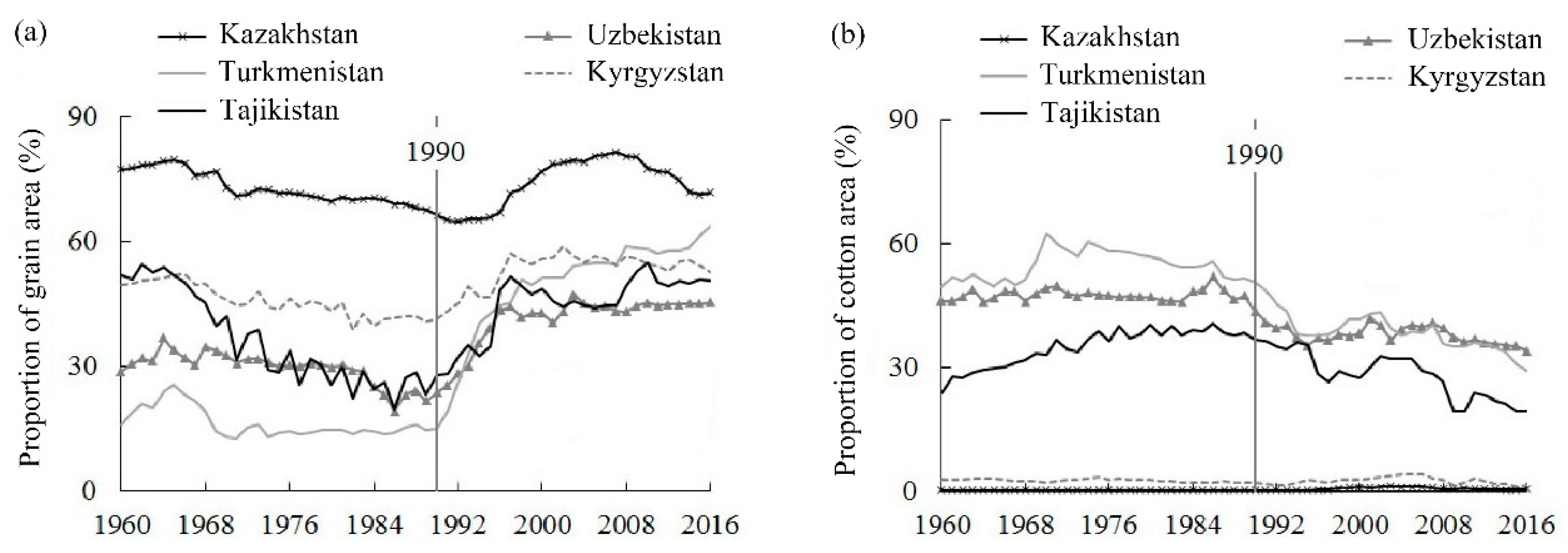



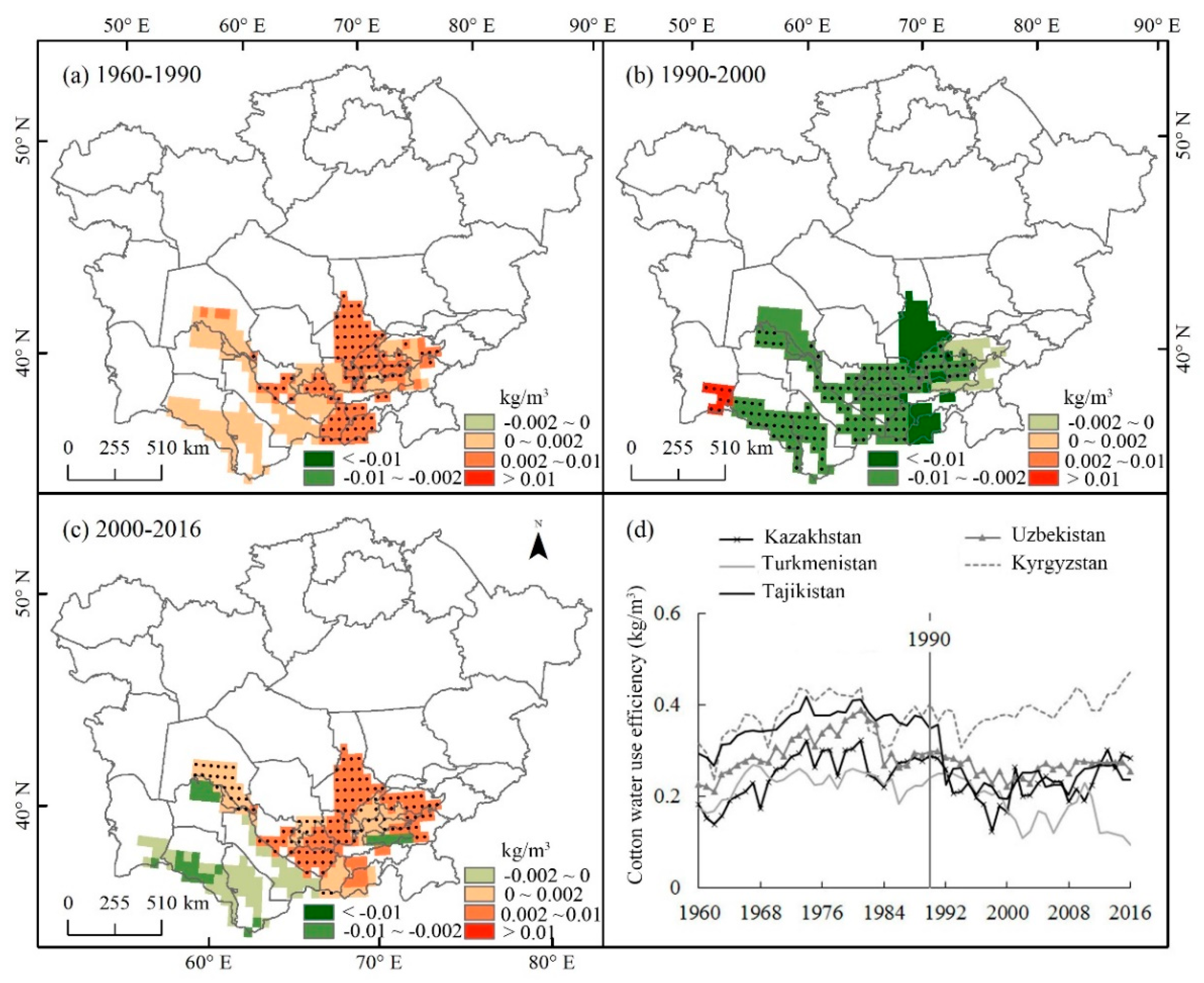
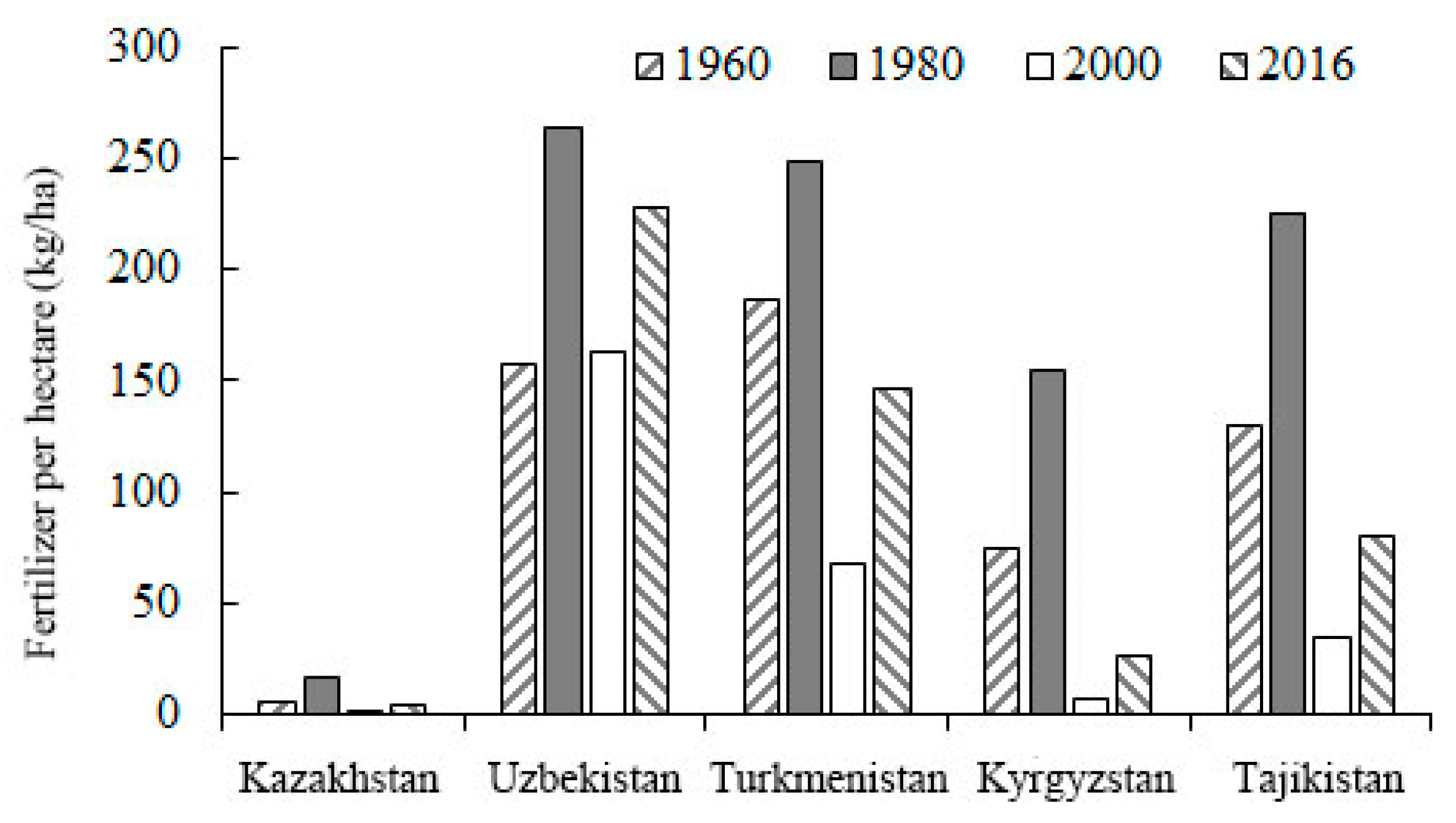
| Data | Description | Spatial Resolution | Period | Source |
|---|---|---|---|---|
| Map | Map before the collapse of the Soviet Union | state | 1990 | Data from 《Atlas of the Soviet socialist republic》 |
| Map of the five Central Asian countries | 2010 | 《World country map》 | ||
| Meteorological Data | Temperature and potential evapotranspiration | 500 m | 1960–2016 | https://crudata.uea.ac.uk/cru/data |
| LULC Data | Spatial distribution data of cultivated land | 300 m | 1975, 2005, 2015 | Visual interpretation from Landsat data |
| Agricultural Statistics Data | Sown area, grain area, and cotton area | state | 1960–2016 | Statistical yearbook 1 |
| Grain yield and cotton yield | state | 1960–2016 |
| Crops | Growth Period and Crop Coefficient | |||||||
|---|---|---|---|---|---|---|---|---|
| Initial Growth Period | Kc | Rapid Growth Period | Kc | Midterm Growth Period | Kc | Maturity Period | Kc | |
| Spring wheat/Barley/Oats | 4/15–4/30 | 0.35 | 5/1–5/25 | 0.75 | 5/26–7/10 | 1.15 | 7/10–8/3 | 0.45 |
| Winter wheat | 10/1–3/20 | 0.35 | 3/21–4/20 | 0.75 | 4/21–6/14 | 1.15 | 6/15–7/15 | 0.45 |
| Rice | 5/10–6/9 | 1.05 | 6/10–7/10 | 1.10 | 7/11–9/10 | 1.20 | 9/11–10/10 | 0.80 |
| Maize | 6/1–6/20 | 0.40 | 6/21–7/25 | 0.80 | 7/26–9/4 | 1.15 | 9/5–10/5 | 0.70 |
| Cotton | 4/10–5/10 | 0.45 | 5/11–6/30 | 0.75 | 7/1–8/25 | 1.15 | 8/26–10/10 | 0.75 |
| Study Area | Methodology | Time | Crop | Crop Water Use Efficiency (kg/m3) | Reference |
|---|---|---|---|---|---|
| Syr Darya Basin | Site observation | 1999–2001 | Cotton | 0.40–0.75 | Abdullaev I [44] |
| Fergana Basin | Site observation | 2009–2010 | Cotton | 0.38–0.89 | Reddy J M [22] |
| Syr Darya Basin 1 | Remote sensing and surface energy balance model | 2006 | Cotton | 0–0.54 | Platonov A [35] |
| Aral Sea Basin | Statistics | 2000–2014 | Grain | 0.88 | Zhang J [25] |
| Cotton | 0.45 | ||||
| Heihe Basin in China | Farmer survey and CROPWAT model | 2013–2015 | Grain | 0.83 | Tan M [29] |
| Central Asia | Remote sensing and statistics | 2000–2016 | Grain | 0.24–0.39 | Our study |
| Cotton | 0.21–0.27 |
© 2020 by the authors. Licensee MDPI, Basel, Switzerland. This article is an open access article distributed under the terms and conditions of the Creative Commons Attribution (CC BY) license (http://creativecommons.org/licenses/by/4.0/).
Share and Cite
Liu, S.; Luo, G.; Wang, H. Temporal and Spatial Changes in Crop Water Use Efficiency in Central Asia from 1960 to 2016. Sustainability 2020, 12, 572. https://doi.org/10.3390/su12020572
Liu S, Luo G, Wang H. Temporal and Spatial Changes in Crop Water Use Efficiency in Central Asia from 1960 to 2016. Sustainability. 2020; 12(2):572. https://doi.org/10.3390/su12020572
Chicago/Turabian StyleLiu, Shuang, Geping Luo, and Hao Wang. 2020. "Temporal and Spatial Changes in Crop Water Use Efficiency in Central Asia from 1960 to 2016" Sustainability 12, no. 2: 572. https://doi.org/10.3390/su12020572
APA StyleLiu, S., Luo, G., & Wang, H. (2020). Temporal and Spatial Changes in Crop Water Use Efficiency in Central Asia from 1960 to 2016. Sustainability, 12(2), 572. https://doi.org/10.3390/su12020572




